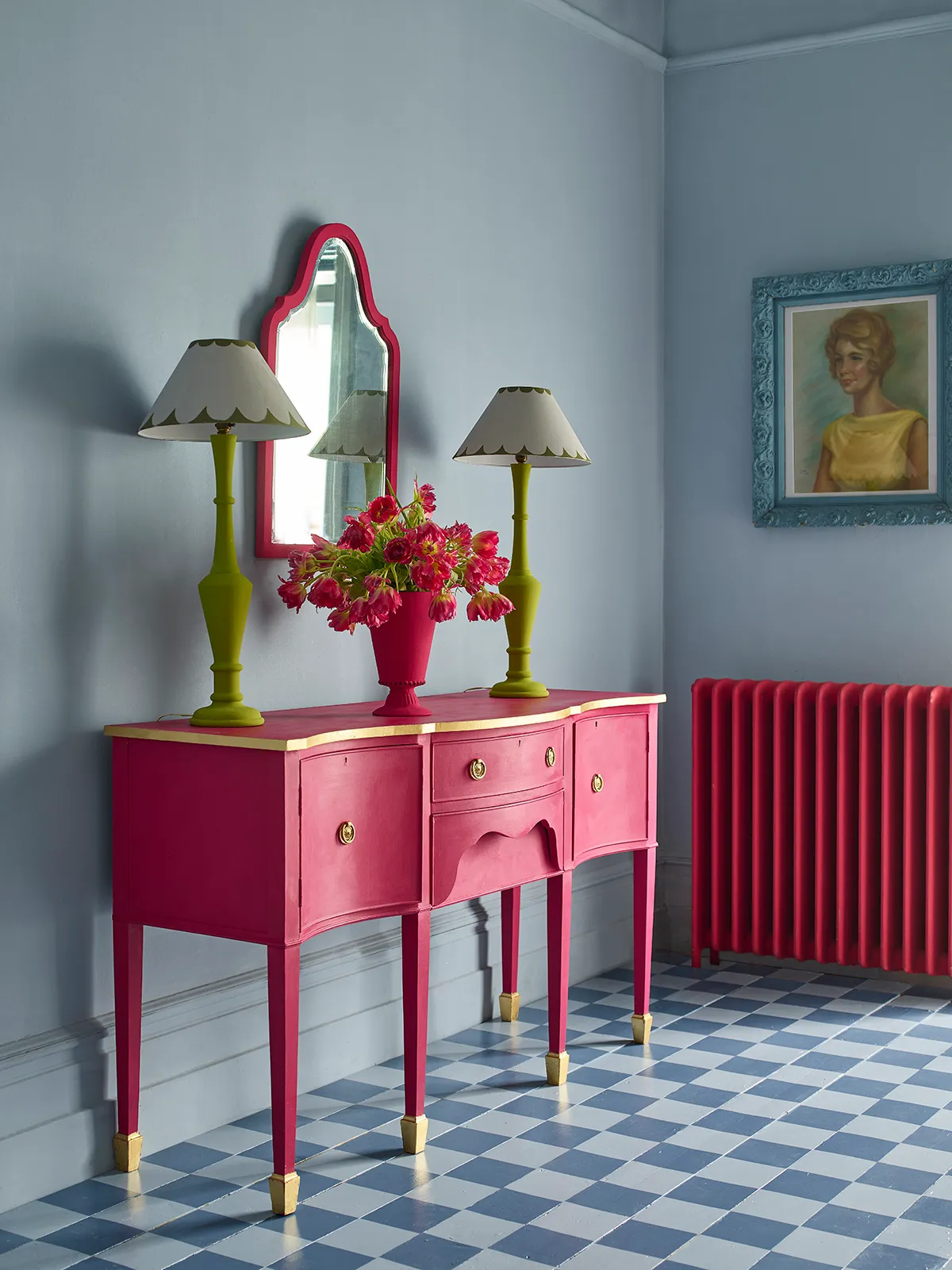With just a lick of paint and a little inspiration you can give any piece of furniture a new look and fall in love with it all over again. Read on for our expert advice on prepping your surfaces, picking your paints, decorating the finished piece, and more.
On a practical note, if you need to update your painting kit, we've tried-and-tested a range of brush sets to find the best paint brushes and put together a buyer's guide of the best painting tools - you're welcome.
How to prepare your furniture for painting
As the old saying goes, failing to prepare is preparing to fail – and the best way to guarantee a great end result when painting a piece of furniture is to appropriately prep your surfaces. Set the piece down and take a good look at it. What is it made from? Is it already painted or varnished? Does it need any repairs? Address these issues now to save yourself a headache later on.
Do you need to sandpaper furniture before painting?
If your project is made of wood it’s always best to start by sanding it all over, especially if it already has an old coating of paint or varnish. Many modern furniture paints boast of being ready-to-apply over previously treated surfaces, but you’ll still get the best results from stripping the item back to bare wood. To save time (and splinters), use an electric sander to strip off the old paint, starting with a coarser grit (around 80 works well) and finishing with a finer one, such as 150.
Once the old coating has been removed and the surface of the wood feels smooth, give the project a wipe down with a clean, lint-free cloth. As well as removing the old paint, the act of sanding will key the surface of the wood, making it easier for new colours to stick.
Should you prime the furniture before painting?
Next you’ll need to prime your project. Not only does applying a layer of primer give the furniture a smooth, even surface but it makes it easier for paint to adhere to it, and lessens the chances of it peeling away.
Find a primer that not only works well with the type of paint you’re going to be using but also the material your project is made from – whether you’re working with wood, metal, plastic or ceramic, there’s a primer out there specifically made for you.
Use a mini foam roller to apply two coats of primer all over the project (or use a spray primer, if you’d prefer), then leave to dry. Once it’s completely set, rub the surface lightly with a fine 220-grit sanding block, then give it another wipe down to remove any residue.
What is the best kind of paint to use on furniture?
With your project prepped and ready to go, it’s time to start painting. With so many different options available, picking the perfect paint can be tricky. Here’s a few popular options to consider:
Chalk Paint: Made famous by interiors guru Annie Sloan, chalk paint has exploded in popularity over the last few years, and for good reason. The matt-finish paint is easy to use and available in a huge range of colours. Chalk paint is water-based and can be easily mixed, and can even be diluted to create sheer colour washes. Once dry, chalk paint should be sealed with a wax or lacquer to keep it safe from wear and tear.
Frenchic paint is also another popular brand with a wealth of colours or you can even have a go at making your own chalk paint...
Acrylic Paint: Also water-based and available in a wide array of colours and finishes, acrylic paint (such as Rust-Oleum’s Painter’s Touch) is another hugely popular option amongst upcyclers. It can be applied to a variety of surfaces and is often available in miniature tins, making it perfect for smaller projects. It can be applied both with a brush and as a spray and is self-levelling.
Oil Paint: Perhaps the most durable of all furniture paints, oil-based colours (such as Dulux’s Non-Drip Gloss) are also the most difficult to work with. Clean-up can be tricky (you’ll need mineral spirits or turpentine on hand to clean the paint brushes) and it can be very thick, leading to unsightly drips. It also takes much longer to dry than water-based paint and has a strong odour. However, the sticky, thick nature of the paint means that it adheres well to almost any surface, lasts for a long time and can withstand knocks and scrapes well.
Is brush or spray paint best for furniture?
Many modern furniture paints come in both traditional brush versions and spray options too – but what’s the difference?
Using a brush paint can be time consuming but allows you to pay attention to detail and get a really fine finish. You can pick from a huge range of different brushes and rollers and should always opt for the best quality you can, ideally picking natural fibres over synthetic ones. Using a brush paint is usually cheaper than opting for a spray, and can be done indoors as it’s less toxic.
Richard Petrie, home expert at Thomas Sanderson, recommends using long, even strokes: 'Brush marks can make your paint job look uneven and messy, so it’s best to not lift up your brush mid-section. Sanding down the spots where brush marks appear and then applying another smooth coat will normally cover them up.'
Alternatively, spray paints provide a quick and easy solution for furniture painting, allowing you to colour larger areas swiftly with a uniform finish. Typically, spray paints are more expensive than brush paints, and need to be applied outdoors. Prevent drips from forming by applying the paint in sweeping, even strokes from a distance of about 30cm.
How to finish and seal furniture

Once your paint has dried it’s a good idea to add a finishing treatment such as a wax, varnish or lacquer to protect it from wear and tear and keep it looking fresh – that is, unless you want to distressed your furniture for a shabby chic look.
Paint expert Annie Sloan had these fab ideas to share: 'You can create washes of colour, thick and textured paint, layered shades, or a smooth modern finish. There are so many different looks and techniques – you can really achieve anything you like!
'One thing I love to do is to put a bold colour on the inside of a piece that is painted in quite a neutral shade on the outside. It’s a good way of introducing colour if you’re not confident with it. I also love creating patterns with stencils – you can layer up a few different designs, or create a repeating pattern. Painting furniture can transform a whole room. I’ve seen so many customers update their kitchen by painting their units, and it looks like a completely new kitchen has been installed!'
Which is best for furniture - wax, varnish or lacquer?
Furniture wax is typically applied over chalk paint using a soft, clean cloth and is buffed across the entire surface of the project. As it sets and soaks into the paint it forms a fine protective layer that not only keeps the colour looking vibrant and fresh but protects it from knocks and scrapes, too. It is available in both clear and dark versions and can be mixed with drops of chalk paint to give it a sheer tinted finish, too.
Lacquer can also be applied over chalk paint, and is intended to provide a more hard-wearing, longer lasting finish. It’s normally applied with a brush (or in spray form) and is ideal for keeping high-traffic surfaces such as tabletops, counter tops and dining chairs protected from scuffs and scrapes, whilst still allowing the colour to take centre stage. It’s generally thought to be the most hard-wearing of the three treatments.
Varnish can be applied over any type of paint and is typically thicker and slower-drying than both wax and lacquer. It’s applied with a brush and normally comes in clear or natural-coloured gloss or satin varieties, unlike lacquer which can be found in a wider range of colours and finishes. Whilst it does protect painted furniture from knocks and bumps it does wear over time and will need to be reapplied and refreshed over the years to stay looking fresh.

